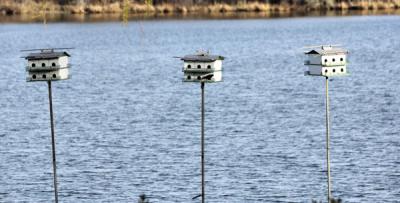Nature Notes: Moment We’ve Waited For

By the time this publishes, we should have blossoms on the shads, sweet cherries, and beach plums, the bird’s-foot violets will turn certain road shoulders purple and the dogwoods in Northwest will be trying to expand their snow-white bracts (they don’t have petals).
One of the major spring events in addition to the return of the ospreys, the upstream swimming of baby eels and adult alewives, and the flowering magnolias, is the return of the swallows, in particular, the tree, barn, cliff, and rough-winged swallows. They never fail us. Vicki Bustamante saw her first tree swallows, the ones with the green wings and white breasts, on April 11 skimming Long Pond in the chain of ponds south of Sag Harbor. Less than a week later she saw all four foraging for insects over one of the ponds behind Third House in the Montauk County Park.
The biggest swallows of all came back on Friday. They arrived at the end of their annual pilgrimage from the deep south, back to their colonies on the west edge of Fort Pond along Endicott Place at Elke Grimm’s. Such returns have been going on throughout the millennium like clockwork. They come back together, no doubt with some offspring from past years. At a time when local bird species are decreasing in numbers each year, the return of the purple martins is a great joy!
When the swallows are back — and keep your eye out for the chimney swifts which are fewer and fewer with each passing year — it means the flying insects are out, the midges, punkies, fungus gnats, and the other ephemerals that emerge from larval lives in the water and ground to strut their stuff, mate, lay their eggs, and fall back to earth dead all in a couple of weeks’ time. It’s all part of life’s game. Fortunately the swallows, flycatchers, and bats that feed on them live for several years if things go right and I have no doubt that at least a few of the martins returning to Elke’s place each year are originals, the ancestors of those that have followed.
Come May and the leafing out of the oaks, hickories, sassafrass and other local hardwoods, it will be the season of the most colorful and soniferous neotropicals of all, the wood warblers. A few are already back, like the pine warbler, the palm warbler, and the yellow warbler, which we didn’t see but heard singing two Saturdays ago at Big Reed Pond in Montauk. The calls that I wait to hear (while I still can) the most from my open window are that of the Baltimore oriole — each male oriole has a slightly different song — and the mews of the gray catbird, both of which arrive at about the same time.
Until then, the purple grackles caterwaul and walk on my leaf-covered yard each day turning over this and that leaf with their bills, gobbling up this and that morsel as they go. On Sunday the Carolina wren with a much smaller bill, but perhaps a much greater zest for life, was right in there with them doing the same thing. I wonder if all Carolina wrens do that or have they learned from watching the grackles?
By the end of the first week in May the terns — least, common, and roseate — should be back to join the piping plovers and the handful of other shorebirds and waterbirds that nest here — the willets, oystercatchers, and skimmers. The ospreys have had a few weeks of easy digs, competing only with cormorants, seals, and a few bald eagles for fish, but from now until October it’s going to be a range war.
And, oh yes, come the first new moon or full moon, those three-million-year-old horseshoe crabs will be approaching the bay shores to lay their eggs at the extreme high tide line. Some of them are as old as us, no doubt. They’ve seen the world from a different perspective. The first one out of the mold was a good one. They haven’t changed much, only grown sparser in population, down through the ages.
Their bluish eggs will be deposited after mating, only to hatch less than a month later during an equally high moon tide. You can bet that the ruddy turnstones and red knots will be gobbling some of the eggs up before hatching, giving them an energy high before they pick up and fly up to the Arctic Circle to breed.
Yes, this is the moment we have all waited for, the flowers, leaves, the sweet odors, the vibrant colors, the songs and calls of late spring. We certainly deserve it, we’ve endured a very tough winter.
Larry Penny can be reached via email at [email protected].
